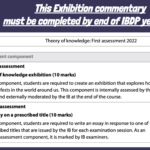“I would like to know more about the difference between interpretation and judgement, because in the quiz, “In my opinion” got me , as I thought it was interpretation but it was actually judgement. So I wish to know more about judgement and interpretation. But of course, if possible, I would like to know more about all 4 steps to strengthen my skills in Art Criticism.”
by a MS1 student | May 2, 2024
Feldman’s model of art criticism provides a framework for analyzing and evaluating artworks. It consists of four steps: description, analysis, interpretation, and judgment. Let’s delve into each step, including the difference between interpretation and judgment.
- Description:
- In this step, you objectively observe and describe the artwork’s visual elements, such as color, line, shape, texture, composition, and subject matter. The goal is to provide an accurate and detailed account of what you see.
- Analysis:
- Here, you analyze how the visual elements in the artwork interact with each other and contribute to its overall meaning or effect. You might explore the use of symbolism, the artist’s technique, or the relationship between form and content. The analysis helps you understand how the artwork is constructed and what artistic choices were made.
- Interpretation:
- Interpretation involves offering personal insights and meaning based on the information gathered from the previous steps. In this phase, you move beyond the objective description and analysis to provide subjective interpretations. You might consider the artwork’s emotional impact, its cultural or historical context, or the artist’s intentions. Interpretation invites a range of perspectives and encourages critical thinking.
- Judgment:
- The final step is making a judgment or evaluation of the artwork. It involves forming an opinion about the overall quality, significance, or success of the artwork. Judgment is subjective and influenced by personal taste, but it should also be informed by the previous steps in the process. When making a judgment, it’s important to support your opinion with evidence and reasoning based on the description, analysis, and interpretation you have done.
Now, let’s address the difference between interpretation and judgment.
Interpretation is focused on understanding and providing personal insights into the meaning or significance of the artwork. It involves exploring different possible meanings, themes, or messages conveyed by the artwork. Interpretation often involves speculation and subjective analysis, as it seeks to uncover the artist’s intentions or the viewer’s own emotional response.
On the other hand, judgment is the act of forming an opinion or evaluation of the artwork. It involves making a value judgment about the artwork’s quality, merit, or effectiveness. Judgment is more concerned with assessing the success or failure of the artwork in achieving its artistic goals. While interpretation is open-ended and allows for diverse viewpoints, judgment involves taking a position and making a critical appraisal.
In the Quiz you took in my VA lesson, you mentioned (“In my opinion…”), it is likely an indication of judgment because it suggests that the person is expressing a personal evaluation or appraisal of the artwork, rather than presenting a subjective interpretation of its meaning.
By practicing the four steps of Feldman’s model—description, analysis, interpretation, and judgment—you can develop a more comprehensive and well-rounded approach to art criticism. Each step contributes to a deeper understanding and appreciation of artworks, allowing you to engage critically with the art you encounter.
by Idy NG






